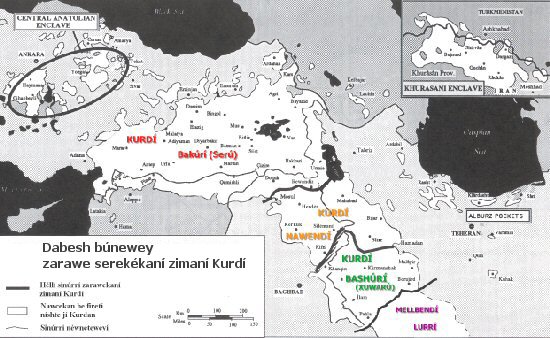
Dialectology is a sub-field of historical linguistics, the scientific study of linguistic dialect. It studies variations in language based primarily on geographic distribution and their associated features. Dialectology treats such topics as divergence of two local dialects from a common ancestor and synchronic variation.
Dialectologists are ultimately concerned with grammatical features which correspond to regional areas. Thus they are usually dealing with populations living in their areas for generations without moving, but also with immigrant groups bringing their languages to new settlements.
The Dialects of Kurdish Language
This section is currently available in Kurdish and Persian only. Please view these section at the provided link below.

Zebíhí (1967); Northern Group ; Central Group ; Southern Group ; Hawrami / Dimili
Table 1) Some alternative names for the Dialect Groups in Kurdish language.
|
M. Izady |
A. Hassanpour |
D.N. MacKenzie |
J. Nebez |
A. Zebíhí |
|
North Kurmânji |
Kurmanci |
Northern Group |
North Kirmanci |
Northern Group |
|
South Kurmânji |
Sorani |
Central Group |
Middle Kirmanci |
Central Group |
|
Dimili |
Hawrami |
Non-Kurdish |
Goraní / Zazai |
Hawrami / Dimili |
|
Gurâni |
Kirmashani |
Southern Group |
South Kirmanci |
Southern Group |
Source:
- Prof. Mínorskí, Kurdnewey médékanin, wergérraní D. Kemal Mezher Ehmed, govarí korrí zanyarí Kurd, Bergí yekem, bendí yekem, Sallí 1973, Bexda, Laperrí 563.
- Dr. Moyín, Burahaní Qatie’, bergí yek, laperrí 37-41.
- Dr. Mihmedí Mukrí, Goraní ya tranehay Kurdí, Taran, Kitébxaney Danish, 1957, laperrí 8.
- Dú nawcey picúkin le mellbendí zarawey Bashúrída.
- Dr. Kemal Fuad, Zarawekaní zimaní Kurdí u zimaní edebí u núsínyan, govarí korrí zanyarí Kurd, Jhimare 4, Sallí 1971, Bexda, Laperrí 22.


